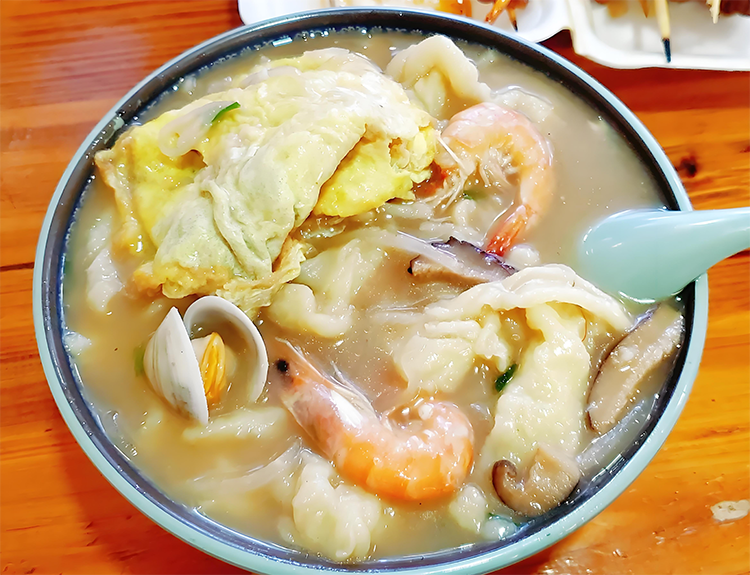Linhai Maixia: Taizhou’s Wheat-Shrimp Noodle
1. A Bowl Full of Mountain-and-Sea Flavors: Discover Linhai Maixia
Imagine strolling beneath the ancient city walls of Taizhou’s Linhai and wandering the old town’s bluestone alleys. A warm, savory aroma drifts from a street stall—the scent of Linhai Maixia, a humble yet unforgettable local comfort food. Not a shrimp dish at all, Maixia is a unique wheat-based noodle shaped like little curved prawns, simmered in a rich, fragrant broth. For visitors seeking authentic Zhejiang street food, tasting Maixia is an essential Taizhou experience.
2. What Is Maixia? A Charming Misunderstanding
At first hearing, many foreign visitors assume Maixia centers on shrimp. This pleasant misunderstanding comes from the name: ‘mai’ refers to wheat, and ‘xia’ describes the shrimp-like appearance of the noodle pieces. Chefs shave a viscous wheat batter into boiling broth, where the strips curl and set like playful prawns. The name captures both visual imagination and local humor, and it highlights the poetic character of Chinese culinary names.

3. Origin and History: Practical Wisdom from Land and Sea
Linhai Maixia emerged from the city’s geography and working-class ingenuity. Facing the East China Sea and backed by Tiantai Mountain, the region was rich in both rice and seafood but not always prosperous. Fisherfolk and farmers turned simple wheat batter and available ingredients—dried seafood, vegetables, and preserved meats—into a nourishing, economical meal. Quick to prepare and filling, Maixia evolved from family kitchens to street stalls, becoming a beloved local staple and a symbol of Taizhou resilience and thrift.
4. Cultural Meaning: A Bowl of Local Life and Homesickness
Maixia is more than sustenance in Linhai; it is a taste of home. For locals working away from home, the first stop after returning is often a favored Maixia shop. One spoonful of steaming broth and familiar noodle aroma wipes away travel fatigue. Served in casual eateries and canteens rather than upscale restaurants, Maixia keeps the town’s everyday warmth alive—local dialect, friendly banter, and a bowl of honest comfort food that carries community memories.

5. Ingredients and Flavor: Mountain and Sea in One Pot
An authentic Linhai Maixia brings together land and sea.
- Noodle batter: Good-quality wheat flour mixed with water and a pinch of salt creates a viscous batter that yields the signature curved, slightly chewy strips.
- Broth: The soul of Maixia. Traditional stocks simmer with shiitake mushrooms, bamboo shoots, shredded lean pork, clams or razor clams, and dried tiny shrimp. Shiitake adds earthy depth, bamboo shoots add springy freshness, and shellfish and dried shrimp pour concentrated ocean umami into the soup.
- Texture and taste: The soup is often silky and full-bodied; the ‘shrimp’ noodle pieces are soft, springy, and able to hold the rich broth. Added toppings—crisp vegetables, tender meat shreds, chopped scallions—create delightful contrasts in every spoonful.
6. Preparation: Street-Side Craft in Plain View
Watching a Maixia maker at work is a small performance. A chef holds a bowl of batter, tilts it, and, using a chopstick or a cleaver edge, rapidly scrapes or flicks lines of batter into a pot of rolling broth. The batter strands instantly set, bobbing and curling like tiny shrimp. The movement is swift and practiced; within minutes a steaming pot of Maixia is ready, garnished with scallions and served piping hot.

7. How to Eat Maixia: Tasting Tips
- Enjoy it as a main meal. Before diving in, scoop a spoonful of broth and blow gently to appreciate the concentrated mountain-and-sea flavors.
- Eat noodles, toppings, and broth together to experience the textural interplay—soft, springy noodles with savory shellfish and crisp vegetables.
- Add a few drops of local rice vinegar or a dash of chili if you like. Vinegar brightens the broth and is a common condiment in Zhejiang cuisine.
- Pair Maixia with small side dishes such as pickled radish or preserved vegetables to cut richness and refresh the palate.
8. Visitor Tips: Where and When to Taste Maixia
- Where to go: The best Maixia is often found in Linhai’s old town and around Ziyang Ancient Street. Follow locals: shops crowded with residents are usually reliable. Look for well-known stalls like Ziyang Maixia and Youlan Maixia.
- When to eat: Maixia works for lunch, dinner, or even late-night snacks—it’s a flexible, all-day comfort food.
- Ordering tips: Maixia is served by the bowl and is generous in portion. Light eaters can share a bowl and order a couple of small sides.
- Pairings: Try Maixia alongside other Taizhou specialties—egg-clear lamb tail (danqing yangwei), seaweed flatbreads, or zao-geng (fermented soup)—for a full local-food tour.

9. Simple Home Recipe: Recreate Maixia at Home
If Maixia wins your heart, try a simplified home version:
- Make the batter: Mix all-purpose flour, water, and a pinch of salt into a batter slightly thicker than yogurt. Rest for 30 minutes.
- Prepare the broth: Sauté shredded lean pork, rehydrated shiitake slices, and bamboo shoots. Add water and bring to a boil, then add clams or dried shrimp and simmer 5–8 minutes. Season with salt and white pepper.
- Scrape the batter: Keep the broth at a gentle boil. Tilt the batter bowl and use chopsticks or a spatula to quickly scrape thin strips into the soup.
- Finish: When the noodles float, cook another 1–2 minutes. Garnish with scallions, a drizzle of sesame oil or a few drops of rice vinegar, and serve hot.
10. Conclusion
Linhai Maixia is a hidden gem tucked in the corners of a historic Zhejiang town. With playful form, a broth that marries mountain and sea, and a humble, homey spirit, Maixia appeals to both the stomach and the heart. When planning a China trip, add Linhai to your itinerary: walk the Jiangnan-style city walls, explore Ziyang Ancient Street, and sit down for a steaming bowl of Maixia. Let this unpretentious noodle dish become one of your warmest travel memories of Taizhou cuisine.


